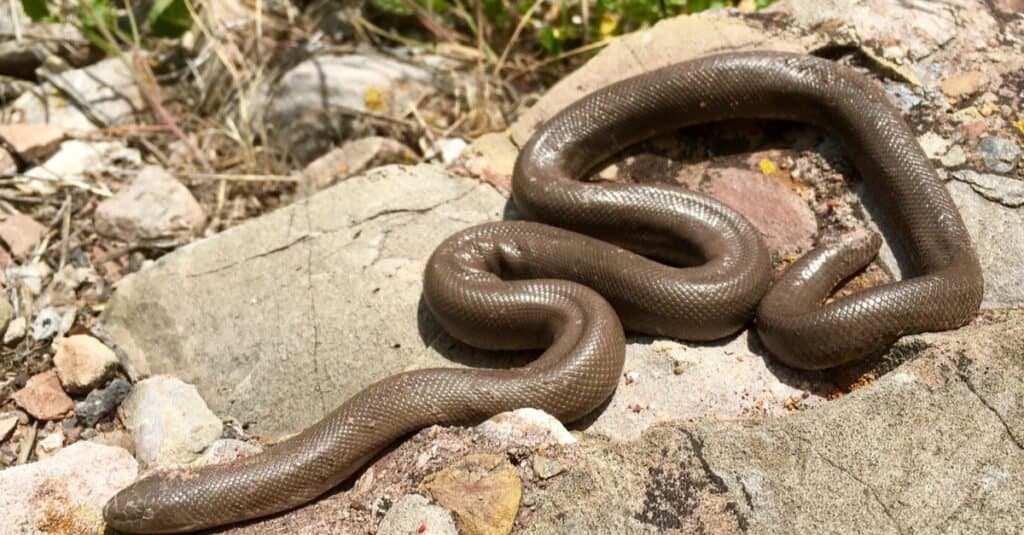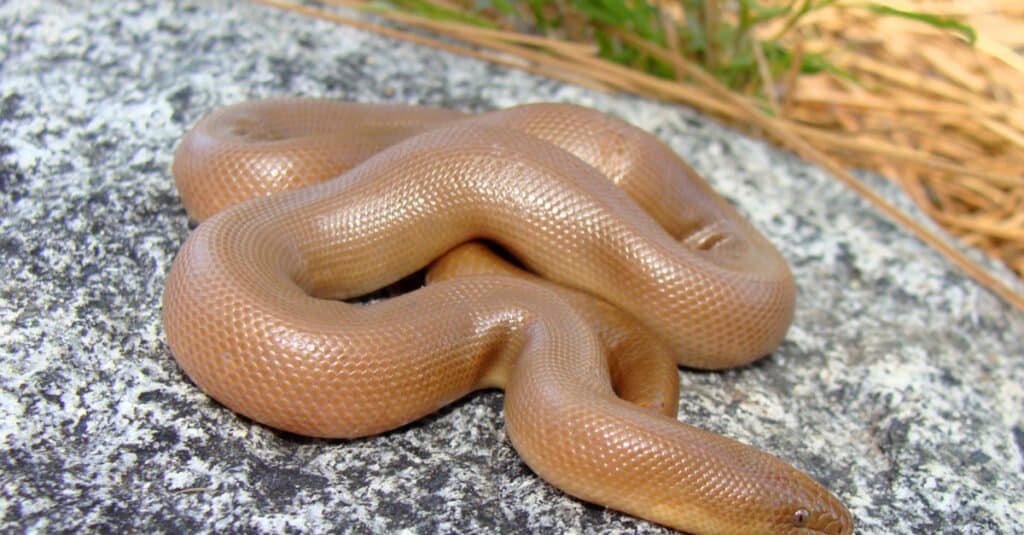The rubber boa may be one of the friendliest snakes that you will ever meet. Native to North America, the rubber boa is a secretive snake that can be challenging to find. However, this little guy is as docile and as nice as snakes come. In fact, rubber boas are commonly used to help those who suffer with Ophidiophobia (the fear of snakes). Rubber boas do not grow nearly as large as some of their tropical cousins, but just how big do they get? Let’s take a closer look at this remarkable snake and discover the largest rubber boa ever recorded!
What Do Rubber Boas Look Like?

Rubber boas can tolerate colder temperatures than most snakes. However, even the winter months are too cold for these snakes, so they move underground to
brumate
(a type of reptilian hibernation).
©yhelfman/Shutterstock.com
Rubber Boas are unique snakes that look a lot like their name suggests – they look like small, rubberized boa constrictors! These snakes are actually related to the much larger pythons and boa constrictors in tropical areas. However, rubber boas are much smaller. Rubber boas have brown, olive-brown, or yellowish-brown backs with very small, smooth scales that give them a somewhat glossy appearance. Their bellies are white, cream, or a pale yellowish color, and in some cases, may have a few small spots. Rubber boas have loose skin covering their large muscles, which they use for constricting their prey. Their loose, wrinkled skin and tiny, smooth scales, give these snakes a texture that feels almost identical to rubber.
The bodies of rubber boas are thick from head to tail, without a lot of variation. They have short, blunt heads that are as wide as the rest of their bodies, with little to no visible neck. Rubber boas also have very small eyes with elliptical pupils. However, their eyes tend to blend in with the color of their scales, so they can be hard to see. The tail of a rubber boa is especially unique because it does not taper at all towards the end. In fact, the end of a rubber boa’s tail is wide and blunt like its head. This is why the rubber boa is also sometimes called the “Two-Headed Snake”. Rubber boas use their tails as part of a unique defense to confuse attackers. Predators often cannot tell which end is the snake’s head and which end is the snake’s tail!
What is the Largest Rubber Boa Ever Recorded?
There are two different species of rubber roas: the northern rubber boa, and the southern rubber boa. Both species look almost identical, but the southern rubber boa does not grow quite as long. At most, southern rubber boas can grow to 19.5-22 inches in length. On the other hand, northern rubber boas can grow to 28 inches in length. On average, northern rubber boas measure between 15-25 inches, and the females are slightly larger than the male snakes. However, the largest rubber boa ever recorded was 33 inches long!
Where Do Rubber Boas Live?

Rubber boas spend most of their time hiding in moist, underground areas. However, on sunny days you might see them warming their bodies on rocks.
©Matt Jeppson/Shutterstock.com
Rubber boas are native to North America. The southern rubber boa is a vulnerable species that only lives in southern California. The northern rubber boa, on the other hand, lives in Canada and the western United States. These snakes have been observed in the U.S. states of Washington, California, Nevada, Utah, Wyoming, and Montana. In fact, they are the largest of the six species of reptiles in Yellowstone National Park. However, rubber boas are rarely seen in Yellowstone because they are very secretive and nocturnal.
Rubber boas live in various habitats but prefer warm, moist environments. Surprisingly, however, these snakes can tolerate much colder temperatures than most other snake species. Rubber boas live in mountainous habitats, meadows, grasslands, forests, and near streams and rivers that have nearby rocky areas, or shrubs and trees. They are very adaptable and are excellent climbers and swimmers. However, rubber boas can be very difficult to find, since these snakes spend most of their time hiding in underground burrows, inside hollow logs, or under leaves and rocks.
Are Rubber Boas Dangerous?
Rubber boas are nonvenomous snakes and are completely harmless to humans. Although they do have very tiny teeth, they almost never bite. In fact, rubber boas are considered one of the friendliest snakes in the world, and they are the most docile of all types of boas. These snakes are timid and not at all aggressive. Many educators actually bring rubber boas along with them when they give presentations to help those who may have a fear of snakes.
When a rubber boa feels threatened, it will curl its body into a ball around its head, leaving only its tail exposed. Since the tail of a rubber boa looks almost identical to its head, the snake can use its tail as a decoy to keep predators away from its actual head. This is a great deterrent for many smaller predators, but not for larger ones like coyotes and foxes. Rubber boas can also release a foul-smelling musk to deter predators. However, their best defense by far is their secretive nature and excellent hiding skills.
What Do Rubber Boas Eat?

Even though they are so much smaller than their tropical cousins, rubber boas have retained small remnant limbs, or “
spurs
”, from their prehistoric ancestors.
©Matt Jeppson/Shutterstock.com
Like other boa species, rubber boas are constrictors that wrap their strong bodies around prey to suffocate it. These snakes eat small mammals like mice, voles, and shrews. They also eat amphibians, other snakes, lizards, and young birds or bats.
Rubber boas are not the fastest snakes, and they are not very aggressive, so they often will look for nests filled with lizard and snake eggs, as well as burrows with small mice. If a rubber boa comes across a nest of mice, they will do their best to consume all the young they can find. If the mother tries to attack the snake, the rubber boa will use its tail to bat her away. This is one of the reasons that many rubber boas have scars and nicks on the ends of their tails.
Rubber Boas as Pets
Rubber boas are docile and gentle snakes. In fact, part of their scientific name, Charina, is a derivative from Greek and means “graceful”. Because these snakes are so timid and nonaggressive, they are sometimes kept as pets. However, it is important to give them the proper type of care. With proper care and handling, rubber boas can easily get use to human interaction. Sometimes they may even curl up in the warmth of your hand. Because these snakes are extremely soft and have such a gentle nature, they can sometimes help with snake phobias.
Up Next
- Discover The Largest Boa Constrictor Ever Caught
- Discover 6 Types of Rattlesnakes In Nevada
- The Top Four Largest (And Most Dangerous) Snakes In Florida
The photo featured at the top of this post is © Matt Jeppson/Shutterstock.com
Discover the "Monster" Snake 5X Bigger than an Anaconda
Every day A-Z Animals sends out some of the most incredible facts in the world from our free newsletter. Want to discover the 10 most beautiful snakes in the world, a "snake island" where you're never more than 3 feet from danger, or a "monster" snake 5X larger than an anaconda? Then sign up right now and you'll start receiving our daily newsletter absolutely free.
Thank you for reading! Have some feedback for us? Contact the AZ Animals editorial team.






